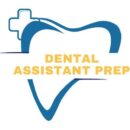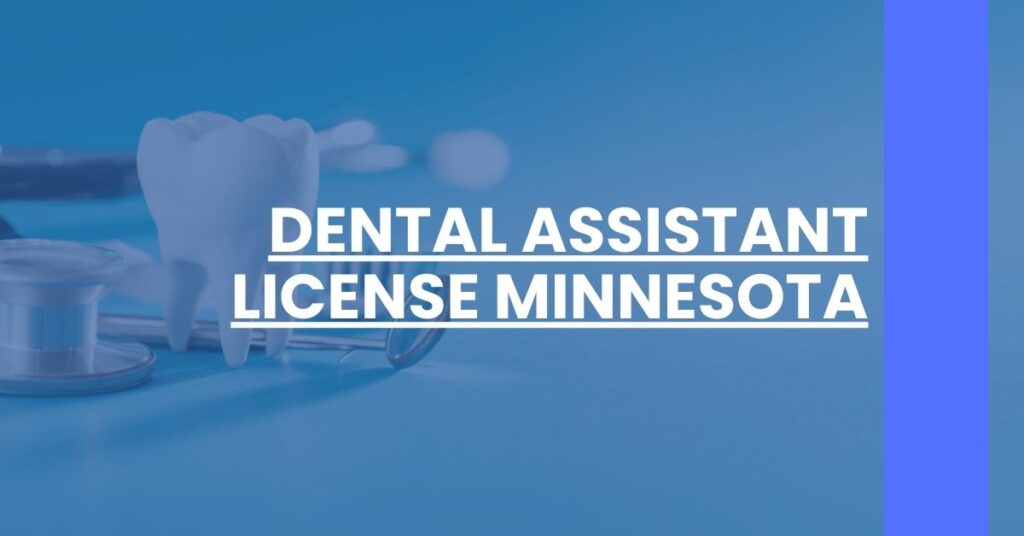Looking for programs in a specific city? Check out our lists of Dental Assistant Programs in Minneapolis, St. Paul, and Rochester.
Obtaining a Dental Assistant License in Minnesota can feel like a maze of rules, exams, and paperwork.
I get it—navigating the licensing process is challenging and often overwhelming. But you’re not alone, and I’m here to help make this journey clearer and less stressful.
Our team has crafted a comprehensive guide covering everything you need to know, including:
- The specific steps to secure your Dental Assistant License in Minnesota
- Educational paths and accreditation essentials for aspiring dental assistants
- Key exams and preparation resources to ensure you’re ready for licensure success
Let’s simplify the process together, one step at a time.
Understand the Dental Assistant Roles and Requirements in Minnesota
Set yourself up for success by first understanding the roles and requirements specific to dental assistants in Minnesota. Unlike other states, Minnesota outlines clear distinctions for various levels of dental assisting.
Levels of Dental Assisting in Minnesota
In Minnesota, you have three primary classifications:
- Dental Assistant: Performs basic support tasks under direct supervision.
- Licensed Dental Assistant (LDA): Carries out advanced tasks, needing official licensure.
- Licensed Dental Assistant with Collaborative Practice Authorization: Allows certain functions in community settings under a collaborative management agreement.
Role-Specific Responsibilities
Each level of dental assisting presents different responsibilities. Generally, a standard Dental Assistant performs tasks like sterilizing instruments and assisting during procedures. An LDA handles more complex duties such as taking dental radiographs and applying sealants, requiring a deeper understanding of dental procedures. In collaborative practice roles, LDAs can engage directly with patients in community health settings, thereby expanding their professional scope.
Necessary Licensing
Obtaining a license is crucial if you will work as an LDA or in a collaborative practice role. The Minnesota Board of Dentistry stipulates these requirements, ensuring that all dental assistants meet high standards for competency and patient care.
Educational Paths for Dental Assistants in Minnesota
Education forms the bedrock of your journey to becoming a licensed dental assistant in Minnesota. Selecting an accredited program paves the way for a successful career.
Accreditation and Its Importance
Attending a Commission on Dental Accreditation (CODA) approved program is essential. Minnesota boasts 14 such accredited dental assistant programs, specifically designed to meet state licensure requirements. Completing one of these programs ensures you receive comprehensive training that meets industry benchmarks.
Coursework and Clinical Training
An accredited program encompasses a wide range of coursework, including:
- Dental Sciences: Gain in-depth knowledge about dental anatomy, physiology, and pathology.
- Radiography: Learn how to properly take and handle dental radiographs.
- Clinical Practices: Acquire hands-on experience in procedures like applying sealants or assisting in surgery.
- Infection Control: Essential for maintaining a sterile work environment and minimizing risks.
These programs generally take about one to two years to complete, combining didactic learning with extensive clinical practice. You can find more details about dental assistant programs here.
Required Examinations for Dental Assistant Licensing
Securing your license necessitates passing key examinations tailored to ensure you meet the requisite skills and knowledge.
National Board Examinations
The Dental Assisting National Board administers the Certified Dental Assistant (CDA) exam, which encompasses three distinct sections:
- General Chairside (GC)
- Radiation Health and Safety (RHS)
- Infection Control (ICE)
Passing these exams demonstrates comprehensive knowledge in critical areas and is a gateway to licensure. Check out some CDA practice tests to help you prepare.
Minnesota State-Specific Exams
In addition, Minnesota mandates the completion of two state-specific exams:
- Minnesota Dental Assistant State Licensing Exam
- Minnesota Jurisprudence Exam
These exams focus on state laws, regulations, and ethical guidelines. Preparation materials and details are available on the Minnesota Board of Dentistry’s website, ensuring you have all necessary resources.
Application Process for a Dental Assistant License in Minnesota
It’s crucial to follow the application steps meticulously to avoid delays.
Application Submission
Begin by downloading the application forms from the Minnesota Board of Dentistry’s website. Essential documents include:
- Proof of Education: You must submit transcripts from your accredited dental assistant program.
- Exam Results: Include proof that you passed the necessary national and state exams.
- CPR Certification: A valid CPR certification is mandatory for licensure.
Fees and Processing
There’s an application fee of $115, and you might need to budget for additional costs like a background check. Ensure all documents and fees are submitted accurately. For a detailed fee schedule, visit the Minnesota Board of Dentistry’s fee structure page.
Common Pitfalls and Tips
Attention to detail can streamline your application process. Double-check all forms for any incomplete or incorrect information. Timely submission of all documents helps expedite processing.
Additional Certifications and Endorsements
Enhancing your qualifications with additional certifications not only broadens your skill set but also opens more job opportunities.
Restorative Functions
Obtaining certification in restorative functions allows you to perform advanced tasks like placing amalgam fillings and composite restorations. You need to complete a board-approved course to earn this credential.
Nitrous Oxide Administration
Certification in nitrous oxide administration enables you to assist in conscious sedation procedures, a valuable skill in many dental practices. Ensure you complete the specific training and pass the related exams.
CPR Certification
Regularly updated CPR certification is not just a licensure requirement. It’s also a crucial skill for patient safety and emergency scenarios.
Explore more about obtaining these certifications on the Minnesota Board of Dentistry’s official website and consider joining professional organizations for additional support and resources.
By diligently following these steps and staying informed about the requirements, you can successfully navigate the path to becoming a licensed dental assistant in Minnesota. Good luck on your journey!
Continuing Education and License Renewal
Requirements to Maintain Your License
Your responsibility as a dental assistant in Minnesota doesn’t end once you obtain your license. Maintaining and renewing your license ensures you continue to meet the evolving standards of the profession.
Continuing Education Credits
The Minnesota Board of Dentistry requires you to complete 25 hours of continuing education (CE) every two years. This ensures you stay current with advancements and best practices in dental care.
Accepted CE Activities
Your CE activities can include:
- Professional Seminars and Workshops: Attending these can cover a significant portion of your required hours.
- Online Courses: Many recognized providers offer courses on various topics related to dental assisting.
- CPR Certification: An updated CPR course is essential, not just for licensure but for patient safety.
Frequency and Documentation
It’s crucial to keep track of your CE activities meticulously. Submit documentation of your credits to the Minnesota Board of Dentistry as part of your renewal application.
Licensing Renewal Process
You need to renew your license every two years. The renewal process includes:
- Completing CE Requirements: Ensure you have all the documentation.
- Filing the Renewal Application: Submit your application before the expiration date. Delays can interrupt your ability to practice.
- Paying Renewal Fees: The renewal fee for a dental assistant license typically amounts to $80.
Following these steps ensures that you maintain an active license and continue to provide high-quality care to your patients.
Job Outlook and Career Opportunities for Dental Assistants in Minnesota
Employment Growth Trends
Dental assisting is a rapidly growing field in Minnesota. The Bureau of Labor Statistics projects a 19.1% growth in employment for dental assistants through 2024. This healthy job market indicates ample opportunities for qualified professionals.
Average Salaries
On average, a dental assistant in Minnesota earns around $62,760 per year. Salaries vary based on experience, location, and the dental office environment.
Career Advancement Opportunities
If you’re looking to advance your career, consider these options:
- Specialization in Dental Procedures: Roles like orthodontic assisting or periodontal scaling can command higher salaries.
- Lead Dental Assistant: Supervisory roles involve managing junior assistants and can be a significant career milestone.
- Continued Education: Pursuing advanced certifications or even transitioning to dental hygiene or dentistry can provide long-term growth.
Networking and Job Resources
Networking within the dental community is instrumental in job searching and professional development. Here are some organizations and resources:
- Minnesota Dental Assistants Association (MDAA): Offers networking events, workshops, and job boards.
- Job Boards: Websites like Indeed and Glassdoor frequently list dental assistant positions.
Resources and Support for Aspiring Dental Assistants
Professional Organizations
Joining professional organizations offers numerous benefits:
- Minnesota Dental Assistants Association (MDAA): Provides access to continuing education, advocacy, and networking events.
- American Dental Assistants Association (ADAA): Offers broader national resources and connections.
Online Forums and Communities
Engaging in online forums can provide invaluable peer support and insights:
- Dental Town: An active community of dental professionals, including dental assistants.
- Reddit Dental Assistants Forum: A place to discuss experiences, challenges, and strategies.
Educational Resources
Like any profession, being well-informed is crucial. Some valuable resources include:
- Dental Assistant Prep: Offers preparatory resources for certification exams and educational guides.
- CDA Practice Tests: Use CDA practice tests to help you prepare for the examination process.
Online Dental Assistant Programs
Advantages of Online Learning
Online programs offer flexibility, allowing you to:
- Study at Your Own Pace: Manage your schedule around work or family commitments.
- Access a Wide Range of Resources: Utilize multimedia content, interactive forums, and virtual labs.
Available Online Programs
Many accredited institutions offer online dental assistant programs:
- Penn Foster College: Offers a comprehensive online dental assistant program.
- Liberty University: Provides courses that prepare you for certification exams and practical applications.
Review more online program options via online dental programs.
Looking for Dental Assistant Information On States Bordering Minnesota?
In addition to Minnesota, we suggest looking for programs in nearby states.
- Dental Assistant License Wisconsin
- Dental Assistant License Iowa
- Dental Assistant License North Dakota
- Dental Assistant License South Dakota
- Dental Assistant License Michigan
Conclusion
Pursuing a career as a dental assistant in Minnesota is a fruitful endeavor. Following the outlined steps ensures you’re well-prepared for the licensing process, continued career growth, and staying current with professional standards. Take the necessary actions, utilize available resources, and stay connected within the dental community for a rewarding career.
For essential steps on renewal, review How To Renew Dental Assistant License.

